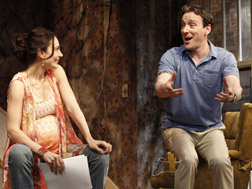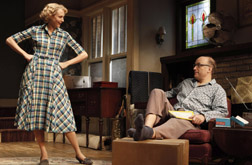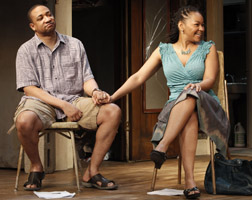Alexander Harrington"Clybourne Park""Clybourne Park"
For those who do not remember the details of Lorraine Hanberry's A Raisin in the Sun and have not heard about this production, Clyboure Park is the fictitious all-white Chicago neighborhood to which Hansberry's African American protagonists the Younger family move despite the efforts of Karl Lindner, the representative of the Clybourne Park Improvement Association. In Act I of Clybourne Park, set in 1959 (the year in which A Raisin in the Sun was produced and, presumably, in which it takes place), Lindner (Jeremy Shamos), having failed to persuade the Youngers to sell their newly-bought home, visits the departing sellers, Russ (Frank Wood) and Bev (Christina Kirk). Implausibly, Russ and Bev have never met the purchasers of their house (only their real estate agent has) and don't know they're black. Deceptively, in its first minutes, the play seems to be a trite caricature of 1950s suburbia. However, Russ is soon revealed to be far more complex than Ozzie Nelson, and his unexpected outbursts prompt surprised laughter from the audience. When Lindner arrives, those members of the audience familiar with A Raisin in the Sun are surprised to discover that his wife (Annie Parisse) is deaf and that their first child was stillborn. The audience has already found out that Russ and Bev have lost their son, and, by the end of the act, it is revealed that the circumstances of his death confronted the community with some harsh truths about America, just as Russ's and Bev's selling the house confronts the community with its own racism.
In Act II, set in 2009, Clybourne Park, having become an all-black neighborhood, is gentrifying. Steve (Shamos) and Lindsey (Parisse) an affluent white couple have bought the house and are planning to tear it down to build a larger one. They are meeting with Kevin (Damon Gupton) and Lena (played by Crystal A. Dickinson -- the character is a relative of Lena Younger, the mother from Hansberry's play) affluent black residents of the neighborhood who are part of a community group that has petitioned the city not to allow Lindsey and Steve build such a large house. The couples are accompanied by their lawyers (Brendan Griffin and Ms. Kirk), both of whom are white. Steve becomes frustrated by Lena's talking about the history of the neighborhood in general terms, rather than directly speaking about its history as a black community. He pushes everyone to speak honestly about race and initiates this by telling a crude sexual joke with a racial dimension, which opens the floodgates, and everyone's hidden feelings about race come pouring out. Norris uses Steve and Lindsey to depict and skewer the attitudes of contemporary white liberals. In a spirit of honesty which Steve would appreciate (I'm not sure about Norris), I admit that I am writing from a similar perspective. To me, the Clybourne Park and Karl Lindner of Norris's play differ from their namesakes in A Raisin in the Sun. In Hansberry's play, Lindner describes the residents of Clybourne Park as "not rich and fancy people, just hardworking, honest people who don't have much but these little homes." This suggests that they are working or lower-middle class. Yet Bev and Russ employ Francine (Dickinson), a uniformed maid, and Lindner refers to a skiing field trip the high school takes – both of these indicate privilege. Yet, in Act II, the petitioners' lawyer says the historic character of the neighborhood is working class. This point may seem petty, but it is easier for an audience to have understanding for the racism of people who are struggling than it is for them to have understanding for the racism of the well-heeled.
On a similar note, Hansberry's Lindner implies that he is acting out of fear that some community members might take violent action against the Youngers. I am sure Hansberry intends the audience to see Lindner as sugarcoating his own racism, and he may even be lying. Norris's Lindner mentions no such fear; the only concern he raises to Bev and Russ is that of declining property values. By taking this justification away from Lindner, Norris also removes an element of complexity. On the other hand, by giving Lindner a deaf wife and stillborn child, Norris adds other complicating and humanizing dimensions to the character. Norris also does this for Russ and Bev: they are humanized by their personal tragedy, and they not depicted and out-and-out racists. Russ is too consumed with grief and anger to care about the question of integrating Clybourne Park, and like Rodney King, Bev sincerely believes we should all try to get along. However, she is oblivious to the condescension of her attempts to connect with Francine and Francine's husband (Gupton). Norris's depiction of this aspect of racial relations (he is, of course, not the first person to notice it), is one of the many things that makes his audience both laugh and cringe. Also, like the Youngers, Russ and Bev are suffering from the community's narrow-mindedness.
The black characters in this play do come off better than the white. Lindsey voices a political correctness that is clearly shallow conformity to the attitudes of her liberal milieu. Like me with my desire for complexity and balance in the depiction of the white characters, Steve argues for a moral equivalency which ignores the enormity of what African Americans have been subjected to, and his rational and tortured explanations for injustice come across as ridiculous. Lena's and Kevin's petition concerns the size of Lindsey and Steve's proposed house – at one point Lena says it's not their race she objects to, it's their taste. I'm sure Norris intends this to come across as camouflage for racism, just like Lindner's argument that people are happier among their own kind. However, Lena's claim is lent credence when a contractor (Wood) asks where he should dig the koi pond. On the other hand, Lena and Kevin are not working or lower-middle class people being displaced by gentrification – they are, themselves, gentrifiers.
I was surprised when a woman in front of me said she found the play offensive. I doubt Norris's points are new or unsettling to Playwrights Horizon's audience. Clybourne Park is not a successful satire because it is challenging. It is successful because, even though these points have already been made, Norris's depiction of them is on target and hysterically funny. One particularly incisive moment has to do with black and white attitudes toward the military. Some of Norris's jokes have nothing to do with race: while he uses Mrs. Lindner's deafness to humanize his characters, he's not above using it for a cheap laugh (this along with references to a grocery bagger with Down's syndrome is sure to bring down Sarah Palin's wrath). Director Pam McKinnon's production builds to a farcical pace when it needs to, but also has its quiet, subtle and emotionally sincere moments. The cast is uniformly strong. | lobby | search
| home | cue-to-cue |
discounts | welcome | film
| dance | reviews
| |
||||||||||






